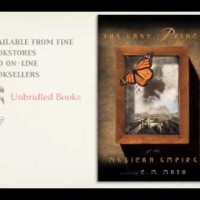Literary historical fiction: C.M. Mayo’s Last Prince of the Mexican Empire

Perhaps the oddest episode in Mexico’s history is the French Emperor Napoleon III’s imposition of a French army-propped Habsburg emperor in the mid-1860s, a military adventure against the democratically elected government of Benito Juarez. Napoleon’s intervention was made possible by the US’s inability to respond to this violation of the Monroe Doctrine during its Civil War with the Confederacy. To make a long story short, the underestimation of the Mexican nation’s persevering will to fight for independence, the French inability to make the adventure pay for itself by draining Mexico of its wealth, the growing pressures put upon Napoleon III by Bismarck’s expansionist Prussia, an eventual American blockade, and the unyielding freeze-out of American political & economic support for the Habsburg Emperor Maximilian led Napoleon III to throw in the towel. The puppet monarch died before a Juarista firing squad in 1867.
That imperial adventure and Mexican resistance to it provide the background for an outstanding literary novel by C. M Mayo, The Last Prince of the Mexican Empire (Unbridled Books,2009, paperback 2010), deservedly awarded a Library Journal Best Book of the Year.
Like the best epics, the story is laser focused on the impact of great, swirling events on individual lives. Much like the Song of Fire and Ice (i.e., Game of Thrones) novels of George R.R. Martin, the story is told through the points of view (POV) of a large cast of characters. Several narrative threads weave in and out, but the heart of the book tells the tale of an American woman, Alicia Green Iturbide, daughter-in-law of the long-deceased first Emperor of Mexico, the self-proclaimed Agustín I, and the mother of the eponymous “Last Prince,” a toddler named Agustín de Iturbide after his father and imperial grandfather. Alicia and her husband, a well-meaning diplomat with no pretensions to imperial ambitions, are persuaded and bullied into giving up their son to the puppet Emperor Maximilian and his Empress Carlota, who named the boy their heir, a cynical charade to persuade the Habsburg family to donate one of Maximilian’s nephews as a truly suitable heir. Within figurative moments after giving up her son, Alicia bitterly regrets her decision and focuses all her energies on trying to get back her boy. The secondary plot involves the unassertive Maximilian’s efforts to decide whether he’d rather wear a crown or chase after butterflies.
In Mayo’s world, not a single character stands on solid ground. Everyone, from emperor and empress to court grandees, soldiers from general to private, priests and a Pope, diplomats, resistance fighters, bandits, nannies and kitchen maids, botanists and entomologists, assorted uncles, aunts, and in-laws, and the toddler himself, everyone, is, in some way, in a world they don’t recognize, cannot reconcile with what was anticipated, is both alluring and repelling, and, for nearly all, a place where they don’t belong. Even the Mexican characters, living in the locale of their birth, or perhaps not far from it, struggle to keep up as they badly fill the needs of the overweening, preening and ever-demanding Europeans. Not every character is fully drawn, fully realized, but the key ones certainly are, and their every conversation rings true. Scores of voices provide a wide range of views, hopes, fears, and day-to-day concerns one would expect within the top-to-bottom society-in-turmoil Mayo presents. It should be noted that, except for a few abruptly violent passages, the actual Juarista war of resistance remains the unseen backdrop for this story of families and nations at cross-purposes.
Mayo, a transplant from the United States who calls Mexico home, also immerses the reader in the sights, colors, textures, sounds, and especially the tropical (and kitchen) aromas of 1860s Mexico, when she is not transporting you to Napoleon’s Paris, Papal Rome, Trieste on the Adriatic, or rural Maryland. An indefatigable and quite intuitive researcher, the author has uncovered hidden family documents in addition to the usual archival sources on both sides of the Atlantic. This ranks among the best historically researched novels I have ever read, and the results show on every page.
Highly recommended to readers of historical fiction drawn to either a mother’s relentless quest to regain her child or to a convincing example of self-delusional hubris among the on-high.


